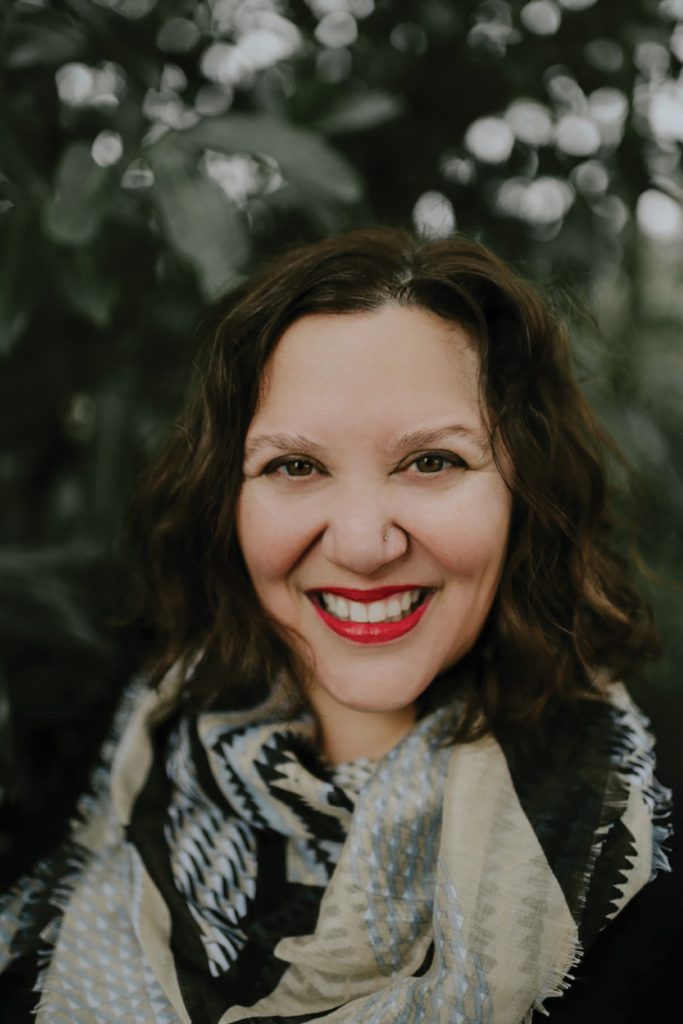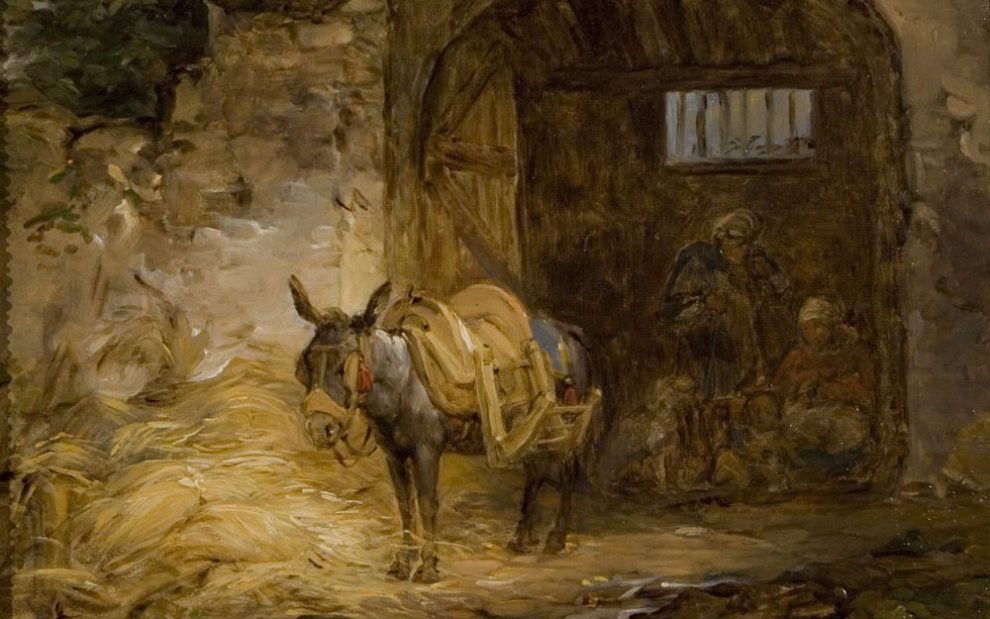
The season of Christmas in contemporary U.S. culture has become an extravaganza of parties, presents, feasting, and decorating. Much of this festive spirit spills over into Advent, which traditionally has been devoted to waiting for the birth of Jesus. Decorating the house, putting up Advent wreaths and Advent calendars, baking holiday treats, and planning reunions with loved ones are all part of the season’s joyful anticipation.
But what if one’s anticipation isn’t joyful? How can people suffering loss, sorrow, trauma, and oppression find their place in a story that is all about hope? Advent, as Catholics know, is supposed to be about waiting for a savior. But for many, it seems that a savior never comes.
In her new book, The First Advent in Palestine (Broadleaf Books), writer and liberation theologian Kelley Nikondeha explores what the world was really like for Mary and Joseph as they prepared for the birth of Jesus. Nikondeha looks at both the historical backdrop of the nativity stories in the gospels and the situation in contemporary Palestine to give us a more accurate picture of Advent in the Bible and its theological significance for those who are poor or oppressed.
What connects liberation theology and Advent in the Bible?
Advent and the nativity bring us into incarnation—God’s arrival into our sphere. And liberation theology deals directly with materiality, with bodies and what those bodies endure. It shows us that we are not just souls destined for the afterlife. Liberation theology requires that we look at the economics, politics, and social dynamics of the world that God entered. We see that on display in the first Advent in the Bible.
Liberation theology is often considered controversial. Why is that?
Liberation theology was introduced through Gustavo Gutiérrez, a Catholic scholar and pastor in Latin America. But it hasn’t always been accepted in the church, because it is political. You can’t talk about bodies without discussing where we’re located and the different forces we negotiate such as violence, oppression, lack of resources, or poverty. These are controversial topics.
But liberation theology believes God cares not only about our souls but about our bodies too. It addresses things that make us uncomfortable such as economics, politics, and social dynamics. People would love to keep theology spiritual. Yet addressing these issues is part of the fullness of salvation.
You describe Mary as “formed by resistance.” What does this mean?
The Galilee region where Mary was from was rife with political, violent, militaristic activities. There was always something going on in Galilee, sometimes military action, sometimes rebellion. Sometimes it was banditry, Robin Hood–style, where desperate people robbed the elites who used their roads. There was all manner of abuse, which always comes down hardest on women.
Mary wasn’t living this pastoral, idyllic existence. She was part of the soil of Galilee, which meant she saw violence daily. She would have seen soldiers humiliating her uncles or cousins. Her neighbors might have gone on raids to try to get weapons. This was the world she lived in and that shaped her.
This came to life for me when I watched the viral video of Palestinian activist Ahed Tamimi slapping a soldier in her front yard when she wasn’t even 16. Tamimi grew up in a village on the West Bank where, like Galilee in Mary’s time, soldiers were always around. Her family was involved in weekly protests.
Watching this young woman, I thought, “How many times did Mary want to lash out at the people oppressing her family and neighbors?” Maybe she didn’t slap a soldier. Maybe she chose the vehicle of song, the way Miriam did, in the Hebrew Bible. But I see Mary as part of resistance to oppression and with a kind of steely strength.
In the Magnificat, when Mary sings of upheaval and the powerful being dethroned, her message is not just spiritual or metaphorical. It’s pretty incendiary. She would have loved to see those who had been harmed be raised up. She would have loved to see the local rulers pushed off their horses. Her song is so much more real in the context of the life she lived.
We have this romanticized image of the first Advent as a time of hope and joy. But you write that the first Advent in the Bible begins in darkness and danger. What was the world Jesus was born into like?
Jesus was born into the Pax Romana. Augustus Caesar had already accomplished world peace, but it was a certain kind of peace, a peace that came through violence. It was a peace for the haves, not for the have-nots. It kept people such as Mary, Joseph, Zechariah, and Elizabeth beaten down, on the edge of survival. Jesus coming into that time is a critique of Caesar’s peace: “You think this is what peace looks like? I’m going to give you another picture of peace.”
Even though Caesar had inaugurated world peace, the Advent story in the Bible takes place during a very fraught time. If you were not one of the elites, you struggled under economic duress.
My husband grew up in Burundi in East Africa and experienced that extreme poverty. Growing up that way doesn’t just mean you don’t have money. It means malnourishment. It means no access to clean water or basic first aid.
Add to that military violence, and you see that it was a very difficult time.
What would it have been like for Mary and Joseph to make that journey to Bethlehem?
The initial audience for the story in Luke’s gospel would have understood that when Caesar tells you to move, you move. There is no negotiation. It doesn’t matter if you’re pregnant or ill. Mary wouldn’t have had control over her schedule or pregnancy. She wouldn’t have known where she’d be having her child or whether she’d be near family.
It would have been an arduous journey from north to south. And people in the north and those in the south didn’t necessarily get along. People in Judea thought that people in Galilee were not the “good Jews.” Mary and Joseph were traveling into territory where they would not necessarily be seen as equals.
We need to understand the economics behind this passage. Luke wasn’t writing about the kind of censuses we have here, where you’re counted to be represented. The only time you were counted was when your taxes went up. Joseph would have been worrying about the economic outlook for his family.
What is the theological significance of Jesus being born into this geopolitical scene?
We understand incarnation to mean that God takes on our humanity, and we have this sense of an uncomplicated incarnation. Yet Jesus was born into a land that was hemorrhaging with pain and loss. He was born into a family that had experienced generational trauma. And we know now that trauma affects our bodies, how we think and react and respond. Poverty creates its own kind of trauma too. We do trauma therapy with kids in Burundi because we understand that extreme poverty has this effect.
Jesus would have experienced this trauma in his human DNA. It would have influenced how he experienced the world, as he lived his 33 years as a brown person from Galilee. And there would have been the added stigma of questions around his paternity.
Jesus grew up with this, and it makes his words even more stunning. When he talks about how to treat enemies and how to react to violence, we hear somebody who is pushing through trauma say, “There’s a different way we can respond.”
Incarnation means that this memory of oppression and trauma is now in the eternal body of God. That gives me great hope. I trust that God will never forget and will bring redemption, even if not on our own timetable. But God knows deeply, in God’s own memory, in God’s own body, what it is to be a traumatized person in this world. That is part of how God interacts with us. And something esoteric like incarnation becomes tangible.
People sometimes are uncomfortable with this, as well as with the idea of Jesus’ sexuality, the question of if he was attracted to people. But these are all parts of humanity.
I had never fully thought about the effects of suffering and violence until I spent some time with these texts. What does it mean that God struggled through violence? What does it mean that God was malnourished?
Can you tell us about the larger, historical role of the political figures who are depicted in the Advent Bible stories?
I’ll focus on King Herod, because he’s the one we hear the most about. Herod was a complex person. He was known for his cruelty both to his citizens and to his own family. He was insecure, vindictive, angry, paranoid—a great person to have in leadership, right?
Herod was Jewish but wasn’t fully seen as being Jewish. There were always questions about how Jewish he was. He married a princess from the Hasmonean dynasty, one of the priestly families of Jewish rulers in Judea at the time. He had a big building campaign to extend the Temple. He was always trying to perform his Jewishness. And it never seemed to be enough because of his collusion with Rome. And that needled him.
He was always trying to appease Caesar and secure his favor, but he also wanted attention. There was a degree of self-aggrandizement with his building projects. He created a surveillance state too: Right outside Bethlehem today is the Herodium, the mountain fortress he built so that he could see from one end of the region to the other. He was also afraid that people weren’t going to mourn him when he died.
Herod was not unlike the tyrannical leaders we have seen since, in Europe or on the African continent or closer to home. These kinds of leaders are insecure. They want to put their name on everything. And it’s all about them.
So, this is what Jesus’ family and neighbors suffered through. Herod died shortly after Jesus was born, but his son followed in his footsteps. He was a pretty menacing presence.
What about the unnamed characters in the Advent Bible stories? What would it have been like to be an innkeeper or a shepherd in that world?
We all hear about the innkeeper who says, “There’s no room at the inn for you.” But if you reread the narratives, there is no innkeeper. We’ve made that up. The reason there wasn’t an innkeeper in Luke’s story is that there was family down there to greet them. Bethlehem was Joseph’s ancestral home.
Yes, it might have been tight. They may have been in a corner with the animals as opposed to in a private room in the family residence, but they weren’t unwelcome.
When I go to Bethlehem, I love to stay at this little inn called Hosh Al-Syrian where the chef is also the innkeeper. Innkeepers in Bethlehem get such a bad rap for something that never happened, he says: “There is no innkeeper in Bethlehem today that would not welcome travelers and that would not welcome a woman in distress.” That is not the way any of the Abrahamic faith traditions would ever respond.
What about the shepherds? What was life like for them?
Shepherds were kind of the essential workers of their day. The markets would have been full of people selling meat, wool, textiles, skins, and the suet used in cooking. It was a whole industry. The shepherds were also the meat suppliers for Jerusalem and the Temple.
They were absolutely essential and at the same time invisible. Just as today, we don’t talk about our essential workers. We tend to forget who picks our produce and who gets things to the market for us. Shepherds would have been largely unseen or ignored—the last people you would have expected to get an audience with an angelic host.
The fact that they were pulled into this intimate moment tells us that God is different than Caesar. God sees differently, includes different people, and embraces their experience. We miss how revolutionary it is that these nobodies were included in God’s peace agenda.
You write about how the land where Jesus lived is sometimes called the “fifth gospel” because it reveals so much about Jesus’ life. What can we learn about his life and ministry through the region of Palestine today?
Obviously, we recognize Jesus was Jewish, so we associate Jesus with today’s Jewish population in Israel. But I think at present Jesus would have more in common with the Palestinian population in that they live under oppression. Of course, even to say that is uncomfortable and often controversial. But I don’t think you can travel into the West Bank and not see it for what it is: an occupation. There are checkpoints, roadblocks, home demolitions, confiscated land. The economy is purposely kept small and hobbled.
What Jesus experienced was that kind of daily humiliation in having to negotiate the dominant force of his day.
What has helped me as I have studied the region is to recognize that Israelites and Palestinians are both deeply traumatized peoples. The Jewish people in Israel have a deep connection to what happened in the Holocaust, the terrible loss they experienced and still experience, the fear of annihilation they continue to live with. And for the Palestinian people, it’s the Nakba, what happened in 1948 when people came from Europe—to seek a safe place, understandably, but the Palestinian people were pushed out.
The trauma for both communities is real. The fears they carry are real. The challenges for peace are real. And we have to embrace the fact that it’s really complex.
What are the implications of seeing the Advent Bible stories as images of resistance for people experiencing oppression today?
When everything in the story is glowing and shiny, all magic and angels and stars, that is not very helpful to those suffering oppression, except for as escapism. I know a lot of people in East Africa for whom escapism is one route. But these stories are all about economies, ruthless leaders, and military operations. It’s a world that is deeply familiar to oppressed people.
I want to be careful not to prescribe how people should read the text. People who are experiencing oppression can make their own connections. This is where I trust that the Spirit continues to work: If I talk about the first liberation theology and Advent in the Bible, people who live in similar situations today can say, “Ah, I hear what the Spirit is saying to me in my neighborhood.” Whether that’s a neighborhood in the Bronx or in Compton or in Gaza.
I recently had a conversation with a Burundian pastor about Herod and some of the things we’ve talked about here. He said, “I can preach Advent differently this year because it’s not unlike what we in Burundi have suffered.”
Even for people who are not experiencing political oppression, the holiday season can be difficult due to trauma or loss. How can understanding the realities of the first Advent in the Bible create a space for healing?
Over the last 10 years, coming into Advent I would feel this sense of darkness. I would become so aware of what wasn’t right in the world. Whether it was refugee children drowning or the maternal mortality rate for Black women in the United States—these realities started grabbing my attention during Advent. And the pandemic has made this more real. I lost people that I knew and loved. Friends of mine have lost parents.
I felt as if I was an anomaly. Everybody else was getting ready for this brilliant season of light and hope and magic. I turned to these texts in the Gospels of Matthew and Luke, thinking I was amiss with my sense of foreboding, hoping they would reorient me. But what I found in the text was deeply congruent with my feelings. There was injustice. There was loss.
And maybe feeling this sense of darkness is faithful to the season. It gave me permission to embrace that darkness and to name those sorrows, whether they were larger, societal tragedies or things more personal to me. Naming these losses, feeling the deep sadness of them, is actually deeply faithful.
It makes me aware of why we needed the incarnation, why God stepping into solidarity with us matters so much.
It’s become a really important part of Advent for me, to name these things I want God to heal and what I know needs to be transformed in me if I am to become part of that peacemaking campaign that the Advent story in the Bible begins to tell us.
Our idea of Advent is anticipation, expecting good things. But the people in the gospel stories were expecting nothing but doom and destruction—the tax increase, the land to be forfeited. Waiting when there is no hope on the horizon—that’s truer to Advent waiting. I may not see hope, but I entrust myself to God, who has this experience of the world in God’s body and God’s memory.
This article also appears in the December 2022 issue of U.S. Catholic (Vol. 87, No. 12, pages 22-25). Click here to subscribe to the magazine.
Image: Saddled Donkey, by Aleksander Laureus (1820s). Wikimedia Commons













Add comment